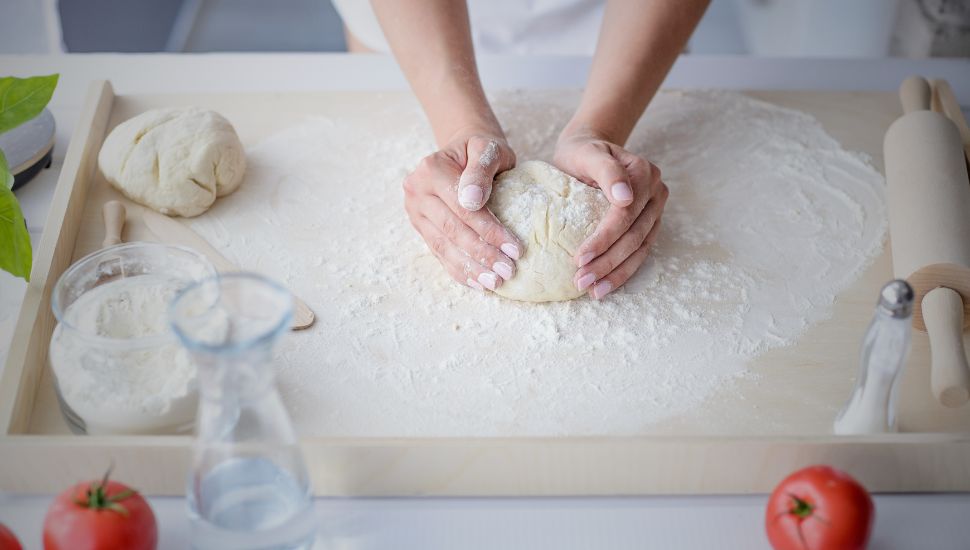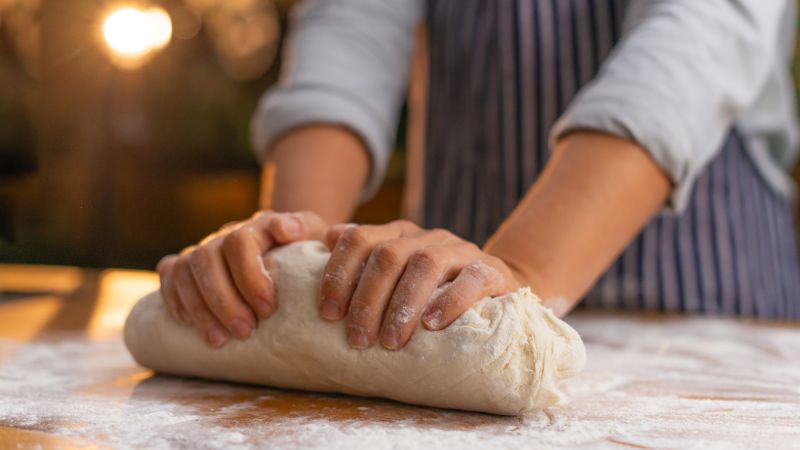
Are you ready to embark on a mouthwatering adventure of creating homemade pizza from scratch? The important thing to do to achieve that perfect, chewy crust is to master the art of kneading the dough.
Kneading may seem like a tiring task, but fear not! With a bit of practice and a sprinkle of enthusiasm, you’ll soon become a pro at kneading, and it also won’t take you a lot of time to knead.
Kneading pizza dough is more than just mixing ingredients together. It’s a hands-on process that helps develop gluten, giving your pizza crust desirable elasticity and texture.
The rhythmic motion of pressing, folding, and pushing the dough helps distribute the yeast, allowing it to do its magic and create airy pockets that delight every pizza bite.
So, are you ready to be called an expert at kneading pizza dough for the next pizza night?
How to knead pizza dough properly by hand?
Kneading pizza dough by hand is a satisfying process that helps you see your dough turn into a pizza.
Kneading dough by hand is an art that every pizza master knows. And if you, too, want to master this art and get your name in the pizza history book for kneading the softest and the most delicious dough, then you should follow the steps.

Gather required ingredients: Ensure you have flour, water (or milk if you want a soft dough), yeast, olive oil, and salt.
Start by mixing all these in the ratio you wish to; if you take 2 cups flour, then half a cup of water and 2 tbsp. olive oil and 1 tsp. salt, start kneading.
Activate your yeast and add it to the dough. Knead until it stops sticking to the surface. And then you’ll need flour for dusting, a clean work surface, and of course, your eager hands!
- Dust your work surface: sprinkle a light layer of flour on your work surface. This way, your dough won’t stick to the surface.
- Start kneading: put your dough on the counter and use the end of your hand (the heel) to push it in the opposite direction. Fold it back over itself and repeat the process. Gradually apply pressure and continue kneading for about 8-10 minutes.
- Use your energy: To get the best results from kneading, transfer some of your energy into your hands. Lean forward slightly as you push and fold the dough. This will help develop the gluten strands in the dough, giving it that desired elasticity.
- Keep an eye on consistency: When kneading, keeps a check on consistency and texture. It should be smooth, slightly tacky, and spring back when pressed with your finger. If it sticks everywhere, dust a little flour on it; if dry, sprinkle water.
- Let it rest: once you have done your part and kneaded the dough properly, place it in a bowl, cover it with a slightly wet cloth and put the bowl in a warmer place (oven is a good idea), and then leave it for at least 60 mins so that it doubles in size.
Taking your dough out after an hour will be like a balloon, doubled in size and soft. Then you can do a final (soft) knead and divide it to spread it on your pizza pans.
How to knead pizza dough properly with a mixer?
If you know how to knead by your hand, then it is a plus point that will prove helpful to you when you don’t have ready-made dough available or a mixer to knead it.
However, kneading pizza dough becomes a breeze if you have a trusty mixer! Let’s see how your mixer can achieve that perfect pizza dough.
- Ingredients, assemble!: Gather your pizza dough ingredients, including flour, yeast, water, baking soda salt, and any additional spices you want, like parsley, basil, or oregano. Set up your mixer with the dough hook attachment, and make sure it’s ready to take on the doughy challenge.
- Combine the ingredients: your mixer will have its bowl, or you can take any other bowl and add flour, yeast, salt, and soda to it. Give them a quick stir to mix everything. Then, slowly add the water while the mixer runs at a low speed. Let the dough mix for a few minutes until it becomes a big lump.
- Adjust the speed: once the dough starts to come together, slow the mixer’s speed and let it knead for 5-10 minutes while giving short intervals in the middle. Continue to knead until the dough becomes a ball and doesn’t stick to the bowl or mixer blade.
- Check consistency: Pay attention to the dough’s texture as the mixer does its job. It should be slightly sticky but not too sticky. If it is too sticky, add some flour and let it mix. Similarly, if it appears too dry and crumbly, drizzle a little water. Adjust the dough’s consistency until it feels just right.
- Let it rise: as soon as your dough is finalized, put it in a container and cover it with something. Leave it to let the yeast do its magic, and the dough rises.
Using a mixer can get you the perfect dough without using your energy. It’s like having your very own dough-whispering assistant in the kitchen.
Why Is Kneading Pizza Dough Important?
Kneading is super important because without kneading, you won’t get that fantastic pizza that you drool over.
It activates the gluten strands, creating a net that traps carbon dioxide produced by the yeast during fermentation. This trapped gas gives the dough an airy and light texture, resulting in a chewy and delicious crust.
Proper kneading also ensures an even distribution of moisture and ingredients throughout the dough. This creates a consistent texture, creating a balanced and chewy bite in every slice.

Kneading helps to normalize the dough, preventing uneven pockets or dense spots from forming. Through kneading, the proteins in the flour form bonds, resulting in a stronger dough structure.
This strength is needed for keeping toppings, sauce, and cheese in place without the crust becoming overly floppy or soggy.
It also allows the ingredients to come together, improving flavor development. The fermentation process, fueled by the yeast, is improved by kneading. This gives the dough time to develop complex flavors as the yeast metabolizes sugars in the flour.
How long should you knead pizza dough?
Kneading pizza dough depends on the recipe you are referring to and also on the number of ingredients. If you are kneading a large batch, then it will take more time compared to kneading dough for a single pizza.
However, generally, you should knead it for a good 10 minutes to achieve smoothness and elasticity. Also, remember that the dough will be ready when you can see it is smooth and round, like a baby’s skin.
There won’t be any dents or bump on it. And when you poke it lightly, it will bounce right back up. Keep kneading until perfect consistency is achieved.
More guides:
- How to keep pizza warm in the oven
- How to defrost pizza dough
- How to keep pizza warm for a party
- Can you freeze papa murphy’s pizza?
How do you know if pizza dough is under-kneaded?
You will recognize an under-kneaded dough as soon as you look at it. As we told you, the perfect dough seems as smooth as a baby’s skin.

Anything other than that will be an under-kneaded dough. But here are some more identifiers to recognize it.
- It is likely under-kneaded if the dough feels overly sticky, wet, or loose.
- Under-kneaded dough lacks proper gluten development, leading to a weaker structure and difficulty in shaping and handling.
- It lacks elasticity and fails to stretch easily without tearing.
- It may feel stiff and resist stretching into a thin, pliable crust.
- When baked, the under-kneaded dough produces a denser, less airy texture.
- The dough won’t rise as effectively during fermentation, resulting in a flatter and less desirable crust.
What temperature do you knead pizza dough?
When kneading pizza dough, the temperature plays a significant role in the overall process. Always knead your dough at room temperature, neither too hot nor too cold, because the temperature could ruin it before it becomes pizza.
Working with dough at room temperature helps ensure proper gluten development and fermentation. Normal temperatures promote yeast activity, allowing the dough to rise and develop flavor more efficiently.
If your kitchen is colder than the desired temperature range, you can warm the ingredients slightly or adjust the water temperature to achieve the optimal range. Maintaining the recommended temperature during kneading helps ensure the dough is perfect.
Is it better to knead pizza dough by hand or mixer?
Kneading dough by hand or with a mixture is purely your choice. You will achieve similar results with both methods.

However, with hand kneading your dough, you must put your energy into it. And on the other hand. Mixing it with a mixer does all the work without tiring you. So, it’s your choice!
Final Verdict
By now, you must be the master of kneading dough, or should I call you Master Dough-Fu? Just kidding.
So, now you can knead your dough either with your hand or with a mixture to achieve that fluffy and soft texture in your pizza.
Your perfect dough will make people lick their fingers because the pizza will be irresistibly delicious!









